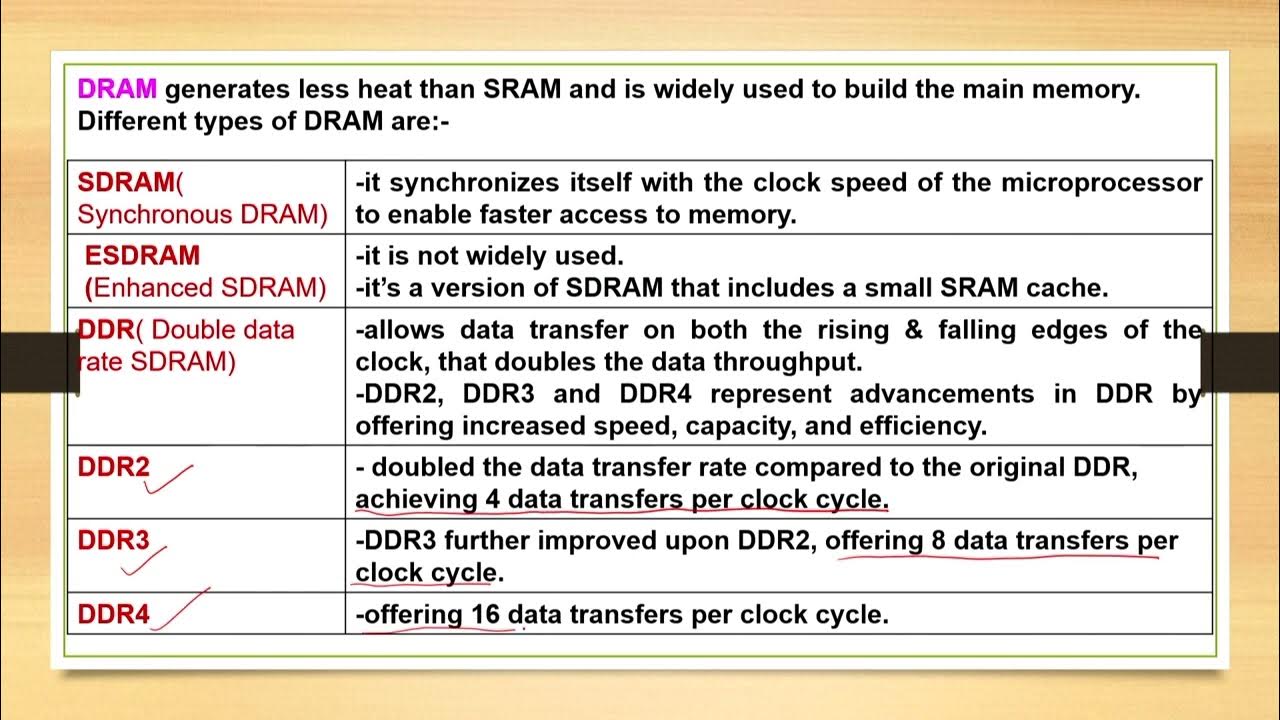How does Virtual Memory work?
Summary
TLDRThis video explains how virtual memory works in computers, helping users understand how RAM, secondary storage (like hard drives or SSDs), and the CPU interact to manage multiple programs simultaneously. When RAM fills up, virtual memory temporarily moves data to secondary storage, freeing up space in RAM for other tasks. The video highlights the benefits of multitasking, but also addresses the downsides, including slower performance and potential disk thrashing, especially with hard drives. Overall, virtual memory allows more efficient program management, though it comes with performance trade-offs.
Takeaways
- 😀 Virtual memory allows a computer to run more programs than the available RAM can support.
- 😀 When RAM is full, virtual memory swaps less-used data to secondary storage (e.g., hard drive or SSD).
- 😀 The process of moving data between RAM and secondary storage is known as 'swapping'.
- 😀 Virtual memory helps free up space in RAM, enabling multitasking by running multiple programs simultaneously.
- 😀 Data swapped out to secondary storage can be brought back into RAM when needed, such as when reopening a program.
- 😀 Although virtual memory enables more efficient multitasking, the swapping process can slow down the system.
- 😀 Virtual memory can lead to performance issues if too many programs are open and data is constantly swapped.
- 😀 Disk thrashing may occur when using a hard drive for virtual memory, causing the disk to work constantly.
- 😀 Disk thrashing can reduce the lifespan of a hard drive due to excessive wear and tear from continuous use.
- 😀 While virtual memory is useful for managing multiple programs, its performance is significantly slower than using physical RAM.
Q & A
What is virtual memory?
-Virtual memory is a memory management technique that uses secondary storage, like a hard drive or SSD, to extend the available RAM. It temporarily holds data not actively used in RAM, allowing multiple programs to run simultaneously.
Why is virtual memory necessary?
-Virtual memory is necessary because it helps when the available RAM is insufficient to run multiple programs. It allows the system to free up space in RAM by swapping out less-used data to secondary storage, enabling more programs to be opened.
How does the system decide which data to swap out of RAM?
-The system swaps out the least-used data in RAM, often moving inactive programs or data that have not been recently accessed to the secondary storage. This creates space for new, more active programs to run.
What role does the secondary storage play in virtual memory?
-Secondary storage, such as a hard drive or SSD, acts as a temporary storage space for data that is not actively needed in RAM. This helps free up RAM for other programs, effectively extending the computer's memory capacity.
What happens when the system swaps out a program from RAM?
-When a program is swapped out from RAM, its data is moved to secondary storage temporarily. This allows the system to free up RAM for other programs. If the program is needed again, it is swapped back into RAM.
What is disk thrashing, and how does it relate to virtual memory?
-Disk thrashing occurs when the hard drive is constantly working to swap data between RAM and secondary storage. This happens when virtual memory is heavily used, leading to slow performance and increased wear on the hard drive.
What are the disadvantages of using virtual memory?
-The main disadvantages of virtual memory are slower performance due to the time taken for data swapping, and potential disk thrashing if the system relies heavily on secondary storage. Constant swapping can also shorten the lifespan of hard drives.
Why does using a hard drive as secondary storage for virtual memory make it more susceptible to wear?
-When a hard drive is used for virtual memory, it is constantly writing and reading data as it swaps information in and out of RAM. This frequent activity can cause wear and tear on the drive, potentially shortening its lifespan.
What is the benefit of virtual memory for multitasking?
-Virtual memory enables effective multitasking by allowing multiple programs to run even if the system's RAM is not large enough to support them all at once. It swaps out inactive data to make room for active programs.
Can virtual memory make a program run faster?
-No, virtual memory generally makes programs run slower because the process of swapping data between RAM and secondary storage takes time. However, it allows more programs to run simultaneously, even if the system doesn't have enough physical RAM.
Outlines

Esta sección está disponible solo para usuarios con suscripción. Por favor, mejora tu plan para acceder a esta parte.
Mejorar ahoraMindmap

Esta sección está disponible solo para usuarios con suscripción. Por favor, mejora tu plan para acceder a esta parte.
Mejorar ahoraKeywords

Esta sección está disponible solo para usuarios con suscripción. Por favor, mejora tu plan para acceder a esta parte.
Mejorar ahoraHighlights

Esta sección está disponible solo para usuarios con suscripción. Por favor, mejora tu plan para acceder a esta parte.
Mejorar ahoraTranscripts

Esta sección está disponible solo para usuarios con suscripción. Por favor, mejora tu plan para acceder a esta parte.
Mejorar ahoraVer Más Videos Relacionados

Chapter 1 - Video 1 - Pengenalan Komputer

Primary Memory : Types and differences from Secondary Storage Memory

IGCSE Computer Science 2023-25 - Topic 3: HARDWARE (6) - DATA STORAGE, Primary, Secondary, Cloud

What is Virtual Memory? What Does it Do?

Lecture 06: Computers Memory

Difference Between SSD, HDD and Hybrid Drive
5.0 / 5 (0 votes)
